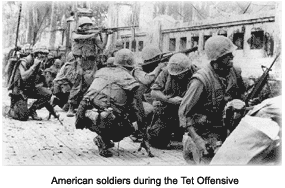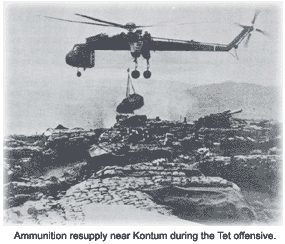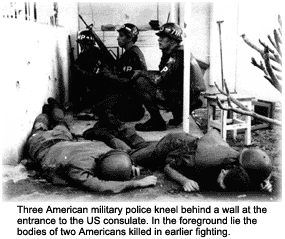The Tet Offensive was a series of surprise attacks by the Vietcong (rebel forces sponsored by North Vietnam) and North Vietnamese forces, on scores of cities, towns, and hamlets throughout South Vietnam. It was considered to be a turning point in the Vietnam War.
 North Vietnamese leaders believed they could not sustain the heavy losses inflicted by the Americans indefinitely and had to win the war with an all-out military effort. In addition, Ho Chi Minh was nearing death, and they needed a victory before that time came.
The combined forces of the Vietcong and the North Vietnamese Regular Army (NVA), about 85,000 strong, launched a major offensive throughout South Vietnam.
The attacks began on January 31, 1968, the first day of the Lunar New Year, Vietnam's most important holiday. It took weeks for U.S. and South Vietnamese troops to retake all of the captured cities, including the former imperial capital of Hue.
North Vietnamese leaders believed they could not sustain the heavy losses inflicted by the Americans indefinitely and had to win the war with an all-out military effort. In addition, Ho Chi Minh was nearing death, and they needed a victory before that time came.
The combined forces of the Vietcong and the North Vietnamese Regular Army (NVA), about 85,000 strong, launched a major offensive throughout South Vietnam.
The attacks began on January 31, 1968, the first day of the Lunar New Year, Vietnam's most important holiday. It took weeks for U.S. and South Vietnamese troops to retake all of the captured cities, including the former imperial capital of Hue.
 Even though the offensive was a military failure for the North Vietnamese Communists and Vietcong (VC), it was a political and psychological victory for them because it dramatically contradicted optimistic claims by the U.S. government that the war was all but over.
The plan unfolds
By late 1967, forces of the U.S. Army, its allies, and the Army of the Republic of Vietnam (ARVN), had entrenched themselves in the six major cities of South Vietnam and were reporting growing success in the countryside.
A series of scattered diversionary attacks by the Vietcong gradually drew more U.S. and ARVN troops away from the cities.
Then in late January 1968, on the first day of Tet, which had previously been observed with a cease-fire, the Vietcong attacked five of South Vietnam's cities, most of its provincial and district capitals, and about 50 hamlets.
In Saigon, they attacked the presidential palace, the airport, the ARVN headquarters, and fought their way onto the U.S. Embassy grounds. The U.S. and ARVN forces, who were caught off guard, quickly responded and within a week had recouped most of the lost territory.
Hue was a different story, however, as the Vietcong held their ground. By the time the city was retaken on February 24, the historic city had been all but leveled. Thousands of civilians were executed and 100,000 residents had lost their homes. It became known as the “Massacre at Hue.”
Even though the offensive was a military failure for the North Vietnamese Communists and Vietcong (VC), it was a political and psychological victory for them because it dramatically contradicted optimistic claims by the U.S. government that the war was all but over.
The plan unfolds
By late 1967, forces of the U.S. Army, its allies, and the Army of the Republic of Vietnam (ARVN), had entrenched themselves in the six major cities of South Vietnam and were reporting growing success in the countryside.
A series of scattered diversionary attacks by the Vietcong gradually drew more U.S. and ARVN troops away from the cities.
Then in late January 1968, on the first day of Tet, which had previously been observed with a cease-fire, the Vietcong attacked five of South Vietnam's cities, most of its provincial and district capitals, and about 50 hamlets.
In Saigon, they attacked the presidential palace, the airport, the ARVN headquarters, and fought their way onto the U.S. Embassy grounds. The U.S. and ARVN forces, who were caught off guard, quickly responded and within a week had recouped most of the lost territory.
Hue was a different story, however, as the Vietcong held their ground. By the time the city was retaken on February 24, the historic city had been all but leveled. Thousands of civilians were executed and 100,000 residents had lost their homes. It became known as the “Massacre at Hue.”
 Aftermath
American spokesmen initially described the Tet offensive as a failure for the Vietcong, pointing to their retreat and staggering casualties. But when General William Westmoreland reported that completing the Vietcong's defeat would necessitate 200,000 more American soldiers and require an activation of the reserves, even loyal supporters of the war effort began to see that a change in strategy was needed.
Aftermath
American spokesmen initially described the Tet offensive as a failure for the Vietcong, pointing to their retreat and staggering casualties. But when General William Westmoreland reported that completing the Vietcong's defeat would necessitate 200,000 more American soldiers and require an activation of the reserves, even loyal supporters of the war effort began to see that a change in strategy was needed.
To a growing segment of the American public, Tet demonstrated the resolve of the Vietcong and the tenuous control South Vietnam had over its own territory. It also helped unite those at home in their dissenting opinions of the war.